“I had been taking two of my rescued greyhounds, who are also trained PAT dogs (Pets As Therapy), into the Norwich University of Arts each week for therapy sessions with the students. On one occasion I was approached by one of the final year students, Beth, who told me that she was making a ‘dogumentary’ about greyhounds and wondered if we could help. Obviously, I am always keen for greyhounds to be portrayed as the wonderful, gentle and patient animals that they are and this proved to be a great opportunity. Beth has been kind enough to allow us to share”, Sue Cole.
Year: 2020
There are two greyhound tracks in Scotland where racing takes place. The official Greyhound Board of Great Britain track at Shawfield in Rutherglen, Glasgow and Thornton, an independent ‘flapper’ track near Glenrothes in Fife.
In recent years there were two GBGB tracks, the other being Powderhall in Edinburgh which closed in 1995 and 7 independent flapper tracks, the last closure being Halcrow at Gretna in 2017. A new track at Wallyford, East Lothian was given planning permission in 2005 and the grandstand erected in anticipation. After a long fight lasting many years which saw the developer continually adjust the plans, planning permission lapsed in March 2020.
Animal welfare is devolved to the Scottish Parliament at Holyrood and as such, the Animal Health & Welfare (Scotland) Act 2006 protects every dog in Scotland including racing greyhounds. It also means that any decision to ban greyhound racing in Scotland will only be taken by the Scottish government.
Thankfully, greyhound racing is in decline in Scotland with both Shawfield and Thornton only holding one race meeting per week. Both tracks state there aren’t enough greyhounds left in Scotland to enable them to hold more meetings although there are several larger Scottish kennels who travel to tracks in the North East of England to race, namely Newcastle, Sunderland and Pelaw Grange.
This year, one of the largest and most notorious racing and breeding kennels, Target in Hawick, Borders, closed after two dogs tested positive for cocaine at Newcastle track in 2019. This was the culmination of two years of consistent doping by Scottish trainers.
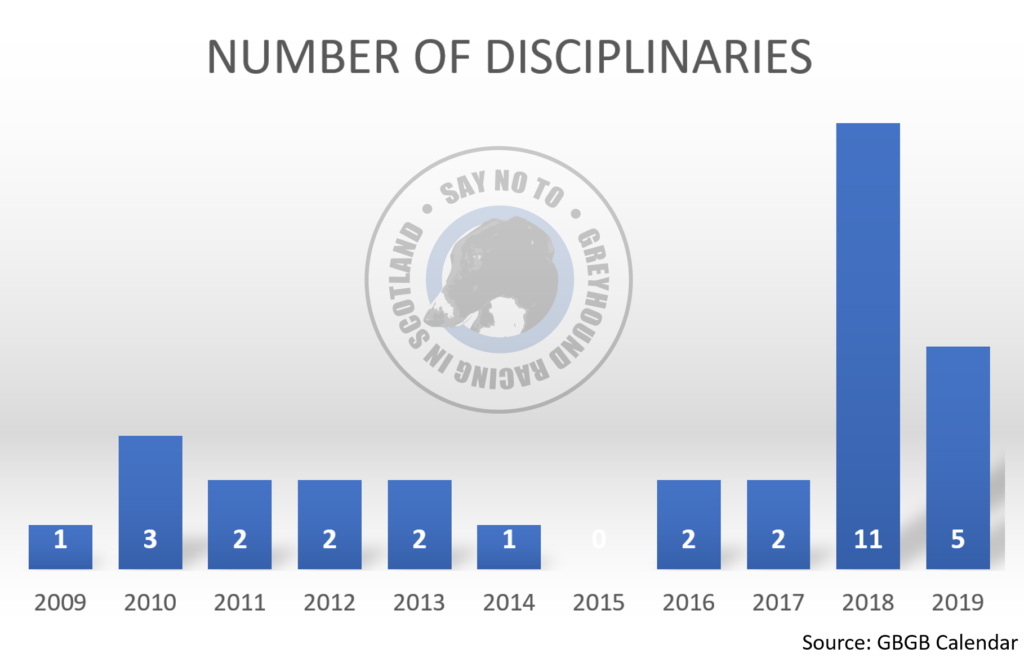
Between 2009 and 2017 there were 15 positive tests including 13 from Shawfield but 2018/19 saw a massive increase in the numbers with 16 positives which included 13 from Shawfield.
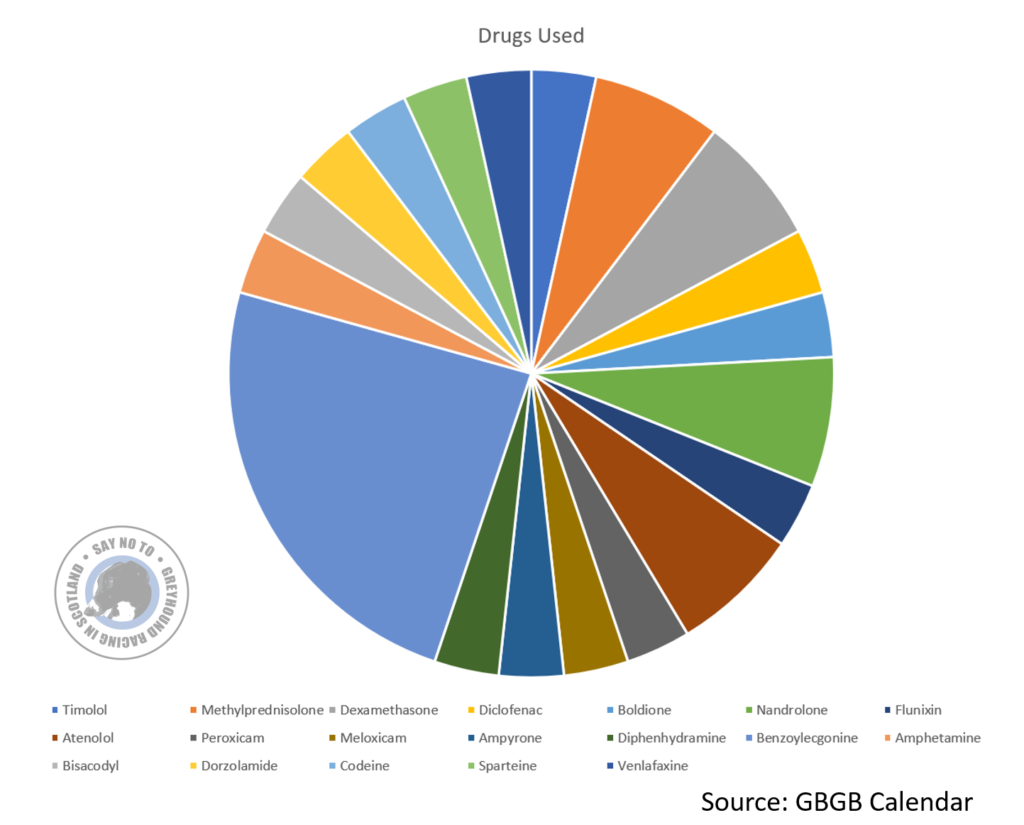
Those 13 tests included 5 for cocaine and others for steroids, stimulants, beta blockers, analgesics and antidepressants. GBGB stated that as a result, the numbers of tests being carried out at Shawfield were increased. Drugging racing greyhounds is a clear breach of the AHW (Scotland) Act 2006 and also therefore breaks the law but incredibly, not one single prosecution has taken place despite our best efforts to make this happen.
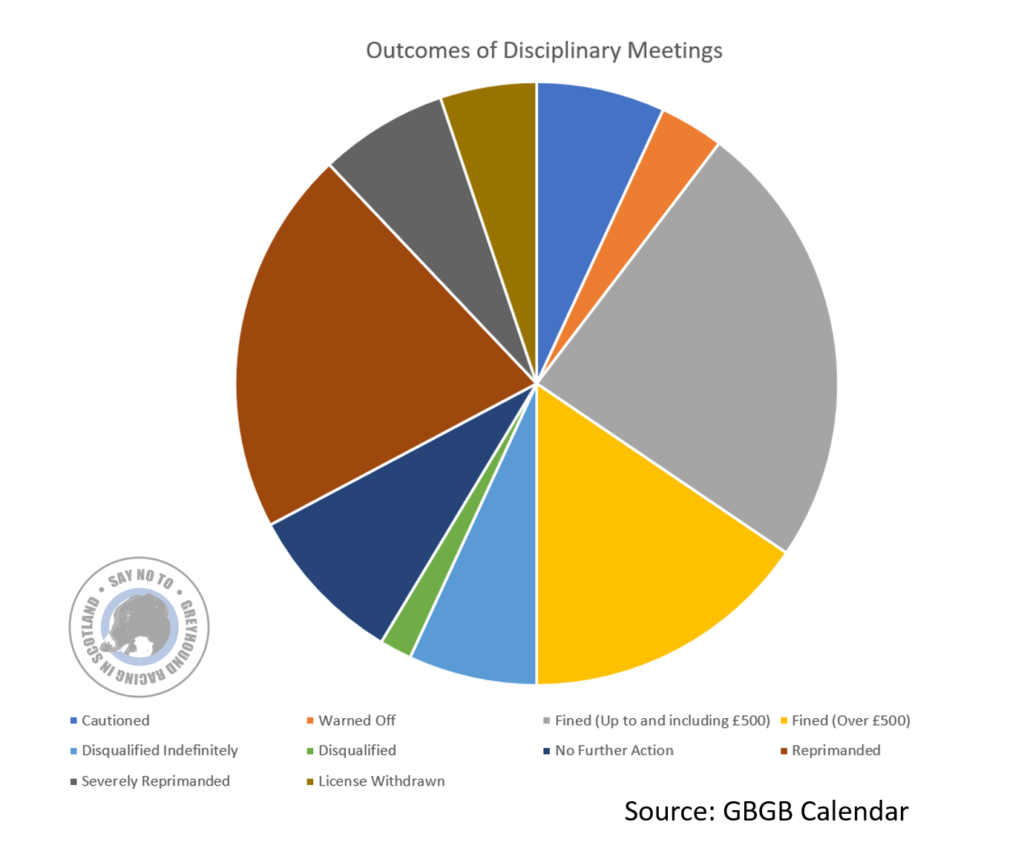
If we take the number of ‘runs’ quoted in the injury and death statistics produced for 2018 which was 426,139 and 410,607 for 2019 and the number of samples quoted in the Greyhound Commitment as ‘more than 15,000’ for October 2017-September 2018 and ‘more than 8000’ for October 2017-September 2018, it shows the approximate percentage of dogs drug tested in the UK to be 3.52% in 2018 and 1.95% in 2019. The figures are approximate as the dates for each year are out by 3 months but this is the GBGB being fully transparent! We know the GBGB have not reported one single doping offence to the Procurator as they told us they did at a meeting of the Cross Party Group on Animal Welfare at the Scottish Parliament.
On 2nd September 2019 a routine inspection by the Stipendiary Steward of a kennel run by a trainer named Chris Sillars, found a black greyhound by the name of Dudleys Forever in a condition described by the Steward as ‘the worst condition of a greyhound I have seen.’ In his opinion it was a matter of animal cruelty. Dudleys Forever was taken to a veterinary surgeon where she was found to weigh 16.3kg with a body score condition of 1/5 and sadly euthanised. The Disciplinary Committee found this to be a breach of the AHW (Scotland) Act and urged the GBGB to send the details of the case to the Crown Office & Procurator Fiscal Service in Edinburgh. We ourselves reported Dudleys Forever’s case to Police Scotland and the SSPCA. No prosecution has taken place to date.
As a group, we are Associate Members of the Cross Party Group for Animal Welfare at Holyrood and in October 2018 we presented to the Group our reasons why greyhound racing should be banned in Scotland. The GBGB were invited to reply and attended in April 2019. Their presentation consisted of a PR exercise for the Greyhound Commitment which we maintain is unachievable. Two promises were made in front of MSPs that night by Mark Bird, Director, and Simon Gower, Chief Veterinary Officer, the first being that the ‘Injury not treated on economic grounds’ tick box would be removed from the Retirement Form for GBGB Registered Greyhounds. Secondly that the GBGB Rules of Racing would be amended to include the Animal Health & Welfare (Scotland) Act 2006 in Rule 2. Unsurprisingly, neither of these promises have been fulfilled and so we still have the ludicrous situation where dogs at Shawfield are running under English welfare regulations according to the GBGB. We will also continue to press for injury and death statistics to be produced independently for Scotland as we believe this is right under devolved animal welfare.

The first greyhound race track in Ireland was opened on 18th April 1927 in Belfast, followed shortly thereafter by a second track at Shelbourne Park in Dublin.
Currently there are 14 greyhound tracks in Southern Ireland – Galway, Dublin, Dundalk, Enniscorthy, Kilkenny, Mullingar, Newbridge, Clonmel, Cork, Limerick, Thurles, Tralee, Waterford and Youghal. In 2019 two further tracks were shut down, Lifford and Longford.
These all are under the control of Bord na gCon which was renamed Rásaíocht Con Éireann (RCE) (Greyhound Racing Ireland) in 2020. https://en.wikipedia.org/wiki/Greyhound_Racing_Ireland
In Northern Ireland there are two further greyhound tracks – Drumbo and Derry. However these tracks are under the control of the Irish Coursing Club (ICC).
https://en.wikipedia.org/wiki/Irish_Coursing_Club
Greyhound Racing Ireland is a commercial semi-state body charged with regulating and promoting greyhound racing in Ireland since its founding in July 1958. It reports to the Department of Agriculture, Food and the Marine.
Since 2001 the Irish government has granted €273 million to the greyhound racing industry.
Some of this funding is taken from a levy on all gambling in Ireland, which has been ring-fenced for the industry.
https://banbloodsports.wordpress.com/2020/08/01/e1-365-billion-irish-government-grants-to-horse-and-greyhound-racing/
In 2020 the amount granted was €16.8m. Without this funding the greyhound racing industry would be ‘goosed’ as claimed by one Irish politician in 2019.
https://www.irishexaminer.com/news/arid-30951839.html
Despite very generous funding from the Irish taxpayer, attendances at greyhound tracks have been in freefall and this trend has continued forward.

Greyhound racing in Ireland is an industry imbued with controversy.
But perhaps a pivotal moment in Irish greyhound racing occurred on 26 June 2019 when one of the country’s mainstream TV stations broadcast a programme named RTÉ Investigates: Greyhounds Running for Their Lives. https://www.youtube.com/watch?v=ZYTb2qBjlMM
The programme revealed many of the industry’s harsh realities but the most shocking information was laid bare through the publication of the Preferred Results Report which had been commissioned by the industry in 2017 at a cost of €115,000 but hidden even from the Department of Agriculture and the Irish Government. On page 26 of the report it was stated that an annual average of almost six thousand greyhounds were killed because they were no longer of use to the industry.
https://www.grireland.ie/globalassets/talking-dogs/pr/preferred-results—igb-organisation-restructuring-report—pages-1—65-compressed.pdf
The final scene of the programme was the most heart-wrenching. Nobody could have prepared for this horrendous scene when a beautiful innocent but unwanted greyhound defecated themselves in fear as they were dragged off into the knackery to be shot in the back of the head while the owner waited in his van for the dog’s collar and lead.
https://www.youtube.com/watch?v=ng6DJCSX1xI
However, in addition to the greyhounds culled by the industry due to their unsuitableness or lack of profitability, we must add to those figures, the number of greyhounds killed at Irish tracks.
These figures have been published following requests for information to the Department of Agriculture.

Years earlier the man ‘credited with building the Irish greyhound industry’ said that it was okay to kill thousands of greyhounds. During an interview on Cork’s 96FM (3rd May 2017), Paschal Taggart, a former chairman of the Irish Greyhound Board, was asked “Do you believe it’s okay for thousands of dogs to be killed in the name of entertainment?”
“I absolutely do,” was Taggart’s appalling response. He stated: “Most of them [the dogs] are kept alive – sorry, some of them are kept alive – and there are ones at the end of their time – they’re injured or that – I do [believe it’s okay to kill them].” https://www.facebook.com/463547953760768/videos/1429782737137280/
In 2017 the world was shocked to hear that a greyhound named ‘Clonbrien Hero’ tested positive for cocaine thrice during The Laurels competition at Curaheen track in Cork.
The greyhound had won the heats final.
https://www.washingtonpost.com/news/early-lead/wp/2017/09/14/championship-irish-greyhound-tests-positive-for-cocaine/
In 2020 the industry’s Control Committee declared that the trainer of ‘Clonbrien Hero’ had ‘no case to answer’ which resulted in the 1st prize of €30,000 being paid out to the dog’s owner/trainer.
https://www.grireland.ie/globalassets/rescource-centre/reports/control/february—2020.pdf
The Irish greyhound industry has always been dogged by issues of greyhounds testing positive for banned and prohibited illegal substances such as methamphetamine, steroids, cocaine etc. Here is a short excerpt from an investigative programme on the issue.
https://www.youtube.com/watch?v=hW5GZC8y3zg
According to the industry’s reports approximately 6% of starting greyhounds at races are tested for drugs, therefore at least 94% of starters are NOT tested. Because of the issues with greyhound drugging, the Greyhound Board of Great Britain (GBGB) mandated that as of 1st Jan 2107, all greyhounds from Ireland who present for competition in the UK must first provide a negative test for drugs.
Greyhound welfare is the top priority for owners of rescued greyhounds all over the world. However, the word ‘welfare’ does not appear in the Irish greyhound industry’s Mission Statement. The industry has a term for their unwanted dogs – ‘wastage’. The industry has a rehoming department but it rehomes less than one thousand greyhounds per year, mainly outside Ireland. Yet in 2019 there were 2324 litters registered, so almost 14,000 individual pups (using an average of 6 pups per litter).
Approximately 6,000 Irish greyhounds a year are registered to race in the UK. It is estimated that 83% of the racing greyhounds in the UK are of Irish origin.
The recent increased awareness about racing greyhounds has led to the Irish public realising that rescued greyhounds make wonderful pets and there has been a huge increase in the number of greyhound adoptions in Ireland. This has also resulted in more people realising that greyhounds deserve to be treated as sentient creatures not as a commodity, and perhaps this is the tipping point where the public objects to the Irish government’s funding of the racing industry and decide that allowing the industry to self regulate will never prevent the exploitation of racing greyhounds.

For further information on greyhound racing in Ireland, please use the following resources.
https://files.grey2kusa.org/pdf/REWARDING-CRUELTY-Greyhound-Racing-in-Ireland.pdf
https://www.facebook.com/IGS-Irish-Greyhound-Spotlight-900980066582339
https://www.facebook.com/banbloodsports/
https://www.facebook.com/GreyhoundAwarenessCork/
Who we are
Facebook: greyt.exploitations Website www.greytexploitations.com Email info@greytexploitations.com Tel: 07958729798
|
|
| Greyt Exploitations was founded in 2008 and campaigns for stronger protection laws and for the gambling on dogs to be outlawed in Britain. We do this by raising the public’s awareness of the cruel and inhumane treatment of greyhounds in the UK and much of our research and investigation work has been published in the national press. | |
| Facebook: StopOwlertongreyhoundracing | |
| Owlerton Greyhound Racing (SOGR) are a Sheffield based anti Greyhound racing group protesting and campaigning for a phased ban on Greyhound racing. | |
| Facebook: GreyhoundAwarenessCork | |
| Greyhound Awareness Cork was set up to help improve the plight of Irish Greyhounds through highlighting issues & information. Many of them are used, abused, neglected and raced to death. We also arrange & attend protests. Up to 83% of the greyhounds racing in the UK are born in Ireland | |
| Facebook: antiracingkent | |
| ARK was founded in 2017 as an antiracing group based in Kent focussed on raising awareness about the plight of racing greyhounds and campaigning for an end to greyhound racing in Kent, the UK and worldwide. We have organised regular antiracing protests outside the main tracks in Kent as well as holding awareness raising stalls at greyhound charity events, and support the work of other UK groups aiming to end the cruelty of greyhound racing in the UK. | |
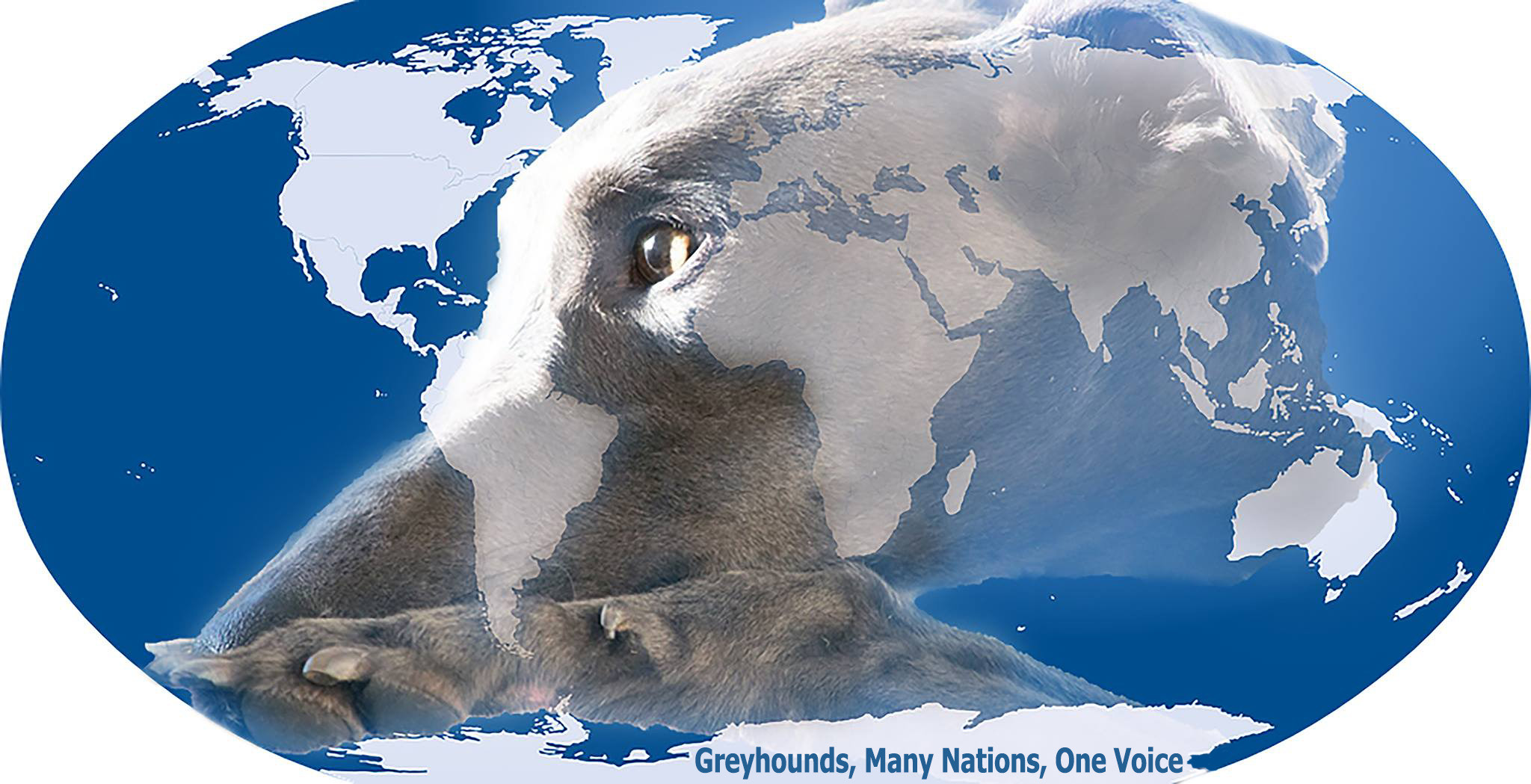 |
Facebook: GMNOV group |
Greyhounds, Many Nations, One Voice was founded in 2016 by a greyhound adopter who volunteers in greyhound rescue and campaigns against greyhound racing in the UK and Ireland. It is an international social media group with members from over 60 countries, that highlights the cruelty in greyhound racing, promotes greyhounds as pets, supports rescues and campaigns to ban greyhound racing worldwide. |
|
Groups that support AAGR
UK
Animal Aid
Animal Welfare Party
The League Against Cruel Sports
Shut Down Belle Vue
OneKind
Shutdown Towcester racecourse
SAGE – Scotland Against Greyhound Exploitation
Kay, Dowager Duchess of Hamilton, ARA
Stop Swindon Greyhound Racing.
Birmingham Against Greyhound Racing
G.A.I.N – Greyhound Action in Nottingham
Doncaster Against Greyhound Racing
INTERNATIONAL:
Pet Levrieri ANIMA Macau
GREY2K USA Worldwide
Protectora y Santuario Scooby, Spain
Busselton Greyhound Awareness
Free the Hounds (Australia)
Projecto Galgo Argentina
Galgo Libre Uruguay
Galgo Libre Chile
Rescues




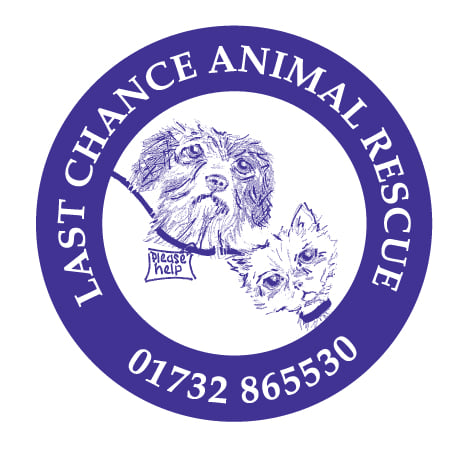
Eddie’s story

Eddie raced 59 times at Newcastle track and won his first race at only 20 months old. He was callously discarded and dumped into a rescue by his trainer at exactly 3 years old, where he languished for a further 5 months. Eddie was severely underweight when he was rescued, his skin was so dry it resembled fish scales and he suffered from bad hair loss all over his body. His upper and lower incisor and canine teeth were ground down to stumps – presumably from chewing on his kennel bars – and his molars and premolars were covered in thick tartar which had to be removed under general anaesthetic. His body was covered in scars, his legs being particularly bad, but his neck is also scarred along with a deep circular scar on his shoulder. He also has muzzle scarring on his face.
When Eddie was taken to the vet the day after he was rescued, his family were told that the wide, four inch long scar on his chest had never been stitched but should have been. Eddie weighed in at 24.5kg and had to gain 7 kilos, slowly, to reach his minimum weight. He is now a healthy 36.5kg. Eddie’s body has healed but by far his biggest problems have been in his mind. After 4 years in a loving home he is still too frightened to go for a walk in the big wide world and many everyday household noises still scare him. He is a creature of habit and has many foibles which his family have grown used to. The first few weeks after rescue were extremely hard for them all and for the other dog who lived in the house, but there was never any question of him being sent back.
Racing severely damages these dogs and Eddie is, unfortunately, one of thousands…
GFP, Scotland
Daisy’s Story
Aged just 2 years old, this girl was dumped on an independent rescue as she was no longer of use to the trainer who raced her at Shawfield track. She suffered from severe anxiety and behavioural problems and her small body was covered in multiple confirmed cigarette burns and scars. Shortly after rescue she was diagnosed with severe cervical spondylosis, chronic back pain and myoclonic epilepsy. Her injuries were thought to be due to trauma received during her short ‘career’. She required daily painkillers, anti-epilepsy drugs and medication to control her anxiety and received regular physiotherapy and behavioural therapy.
The cervical spondylosis worsened over time and this had an impact on the nerve supply to her forelegs. Her pain levels and coordination problems were increasing and in April 2020 this resulted in an emergency admission to the vets. It was discovered shortly afterwards that she had developed osteosarcoma in her humerus. Due to her neck injury, amputation was not a viable option, so she was sent home to make the most of her final months. Her condition worsened rapidly, and it was also discovered that she had a tumour in her lumbar spine. She passed away peacefully with her family in July 2020, just days after her 7th birthday.
We are thankful she found her forever home where she was valued and loved and not seen as a commodity. She was a very much loved little girl by everyone who knew her.
She is one of the many reasons our group will continue to campaign to end Greyhound racing.
Ms E.R, Scotland
Endless thousands of greyhounds have suffered the consequences of greyhound racing since it began 94 years ago. They continue to do so despite the industry’s now desperate attempts to sanitise its existence.
In 1959 I took employment in a trainer’s kennels and witnessed the insensitivity and suffering involved, including dogs often permanently muzzled as a solution to stressed behaviour caused by the conditions and lifestyle they were obliged to endure. No provision was made when injury, loss of speed or unsuitability for purpose ended their usefulness. The common instruction of owners to trainers was: “Give it away or have it put down.” I was taken aback.
Naively, I began advertising for homes, hoping they could then experience some kindness and comfort. I was swiftly instructed by the industry’s ruling body, the National Greyhound Racing Club (nowadays Greyhound Board of Great Britain) to stop immediately. I was told it made it look bad for greyhound racing, presumably because it made it publicly known that the discarded dogs were not provided for, but I discovered a darker side: it was quicker and more profitable to channel them into vivisection laboratories.
The callous instruction was ignored. Owners were always keen to offload their responsibility and glad if a home was found. Only a tiny minority of owners adopted their dogs themselves. Sadly, the need for homes exceeded the supply and as trainers wanted kennel spaces for new stock, I was still regularly required by my employer to despatch surplus discarded dogs by rail to an individual in Norfolk. I was told that he also found homes.
In order to home more dogs myself, I had begun advertising nationwide and contacted the British Union for the Abolition of Vivisection (BUAV) for the help of the experienced volunteers of its Derek Roy Homefinding Scheme for Greyhounds to check the responses for suitability. I asked them to also investigate the Norfolk individual who apparently could take any number of dogs. Responsible homefinding takes time, so he aroused suspicion. In fact, he supplied the dogs to vivisection laboratories. The trainers had lied. When confronted, it emerged that they knew of the dogs’ real fate. “At least they’re doing something useful” was their excuse.
Between 1959 and 1974 I was fortunate to build up a nationwide network of volunteer helpers and worked in association with the BUAV. Understandably, in response to pressure from its supporters who wished their donations to be used towards finding alternatives to vivisection, the BUAV eventually approached the NGRC and embarrassed it to address its own responsibility for the greyhounds. Having opposed advertising for homes for 15 years, the NGRC then had the audacity to ask for my list of contacts to form its Retired Greyhound Trust. Other homefinders, by then attached to various tracks, were also incorporated and required to cough up all monies raised, but fundings subsequently issued towards their homefinding expenses were virtually non-existent.
Eventually a £5 fee was added to the NGRC’s registration charge, similar to the so-called ground-breaking strategy recently employed by the GBGB, with most likely the same inadequate and worrying outcome. Many owners baulked at the imposition, then demanded or expected immediate homes for their retired dogs. This was rarely possible. The best that could be offered was that owners should advertise personally for homes, then contact RGT homing groups to check responses for suitability. Many did not bother with that time-consuming and possibly disappointing refinement, so dogs were off-loaded uncaringly. No records were requested.
Dogs could still be channelled into laboratories or abandoned with their earflap tattoos cut off to avoid traceability, so I asked the NGRC to require owners and trainers to provide details of their dogs’ destinations when their track careers ended. The request was not welcomed and, apart from RGT adoption forms eventually provided, the whereabouts of most discarded dogs remained unrecorded until more recent times when the industry has finally had to comply due to pressure by concerned animal welfare organisations. Even so, figures do not tally and concerns remain.
There are many skeletons in the greyhound industry’s cupboard, not least those of the discarded tools of its trade. A layered mass grave area of thousands of discarded racers was discovered by the Sunday Times in 2006. Low grade racers exported to appalling conditions in Spain, whose suffering the industry ignored for years, are just two examples.
Proof exists of the history outlined so denial is inappropriate and pointless.
Public exposure of the greyhound industry’s welfare failures prompted a balanced Parliamentary enquiry by APGAW in 2006. Fourteen years later its recommendations of a broadened regulatory body and compulsory contributions towards welfare by bookmakers remain unobserved. DEFRA fails its named responsibility for welfare by permitting it to be so.
Under the industry’s continued self-regulation, the dogs remain vulnerable and continue to suffer.
The GBGB states that stewards’ inspections are made twice yearly. The sad condition of dogs in a trainer’s kennels, as reported in the GBGB Calendar of 14th February 2020, indicated longer term neglect than six months. His welfare failures would, therefore, have been evident and should have been noticed much sooner if all stewards were competent and honoured their welfare responsibility. Retribution after the event is too late: the dogs have already suffered by then.
Without a broadened regulatory body, as recommended by APGAW and which could make proper care and conditions compulsory, the GBGB’s recently issued Code of Practice will continue to be ignored by the many trainers who favour their own traditional insensitive practices, including permanent muzzling as a solution to stressed behaviour. The more compassionate measures recommended are considered too time-consuming and unnecessary. The Animal Welfare Act 2006 is contravened and stewards apparently turn a blind eye unless of a conscientious nature.
The GBGB recently stated the figure of 16,800 greyhounds in registered trainers’ kennels. Others have already been born to follow in their footsteps. More are being bred. They all remain vulnerable despite the GBGB’s claim of Commitment to Welfare.
The GBGB’s claim of 90% homing is misleading. It does not cover unregistered dogs, even though they are all part of the industry’s production line and, dogs stockpiled in trainers’ kennels cannot fairly be classed as homed in the recognised sense of the word. There is no real quality of life and saturation point will quickly be reached, as homing groups already struggle to cope with the number needing help. What then?
The solution of ‘bolt gun and bury’ can provably be surreptitious and need not be declared as euthanasia which the industry is now committed to minimise. Research laboratories have also long been a favoured disposal channel. In due course, it will not be out of place to investigate.
Meanwhile, the coordinator of the recently launched GBGB’s Greyhound Retirement Scheme plans to harvest the services of other homing groups in addition to Greyhound Trust groups, thus depriving abandoned dogs and cruelty cases of their chance of a safe haven until lovingly homed. They often arrive as a result of careless homing. The suggestions that the industry should instead use approved and licenced boarding kennels nationwide for dogs on the waiting list for homes, financed from bookmakers’ bulging pockets, have so far been ignored, yet it would also advantageously provide opportunity for the greyhounds to socialise and other customers might often pursue the idea of adopting one.
Despite everyone’s efforts for whatever reason (cosmetic image or genuine compassion) the need for homes far exceeds the supply, even given the services of concerned volunteers and those who are opposed to greyhound racing. The latter are vilified by the industry, yet blatantly used to its own advantage, including many members of the public on whom the industry prevails to provide homes. Unwittingly, they protect its image by doing so.
It cannot be an offence to be opposed to greyhound racing. It is an offence to contravene the Animal Welfare Act 2006.
Covid 19 has already proved that life can well go on without live greyhound racing, plus: it can be replaced by virtual greyhound racing to raise equal revenue and accommodate people’s gambling requirements without causing endless more thousands of greyhounds to suffer.
Live greyhound racing is a disgraceful 94 year old chapter in our history. On humane grounds, may it never make it to a hundred years.
Sincerely
Ann Shannon October 2020
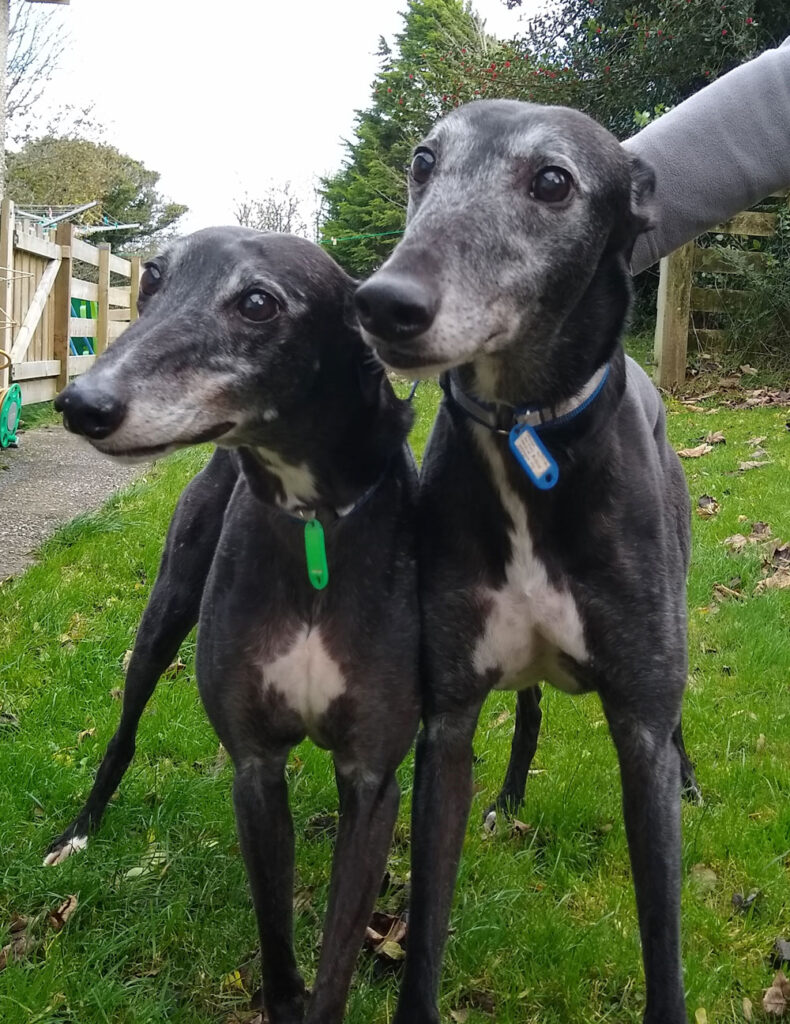
Injuries + Death

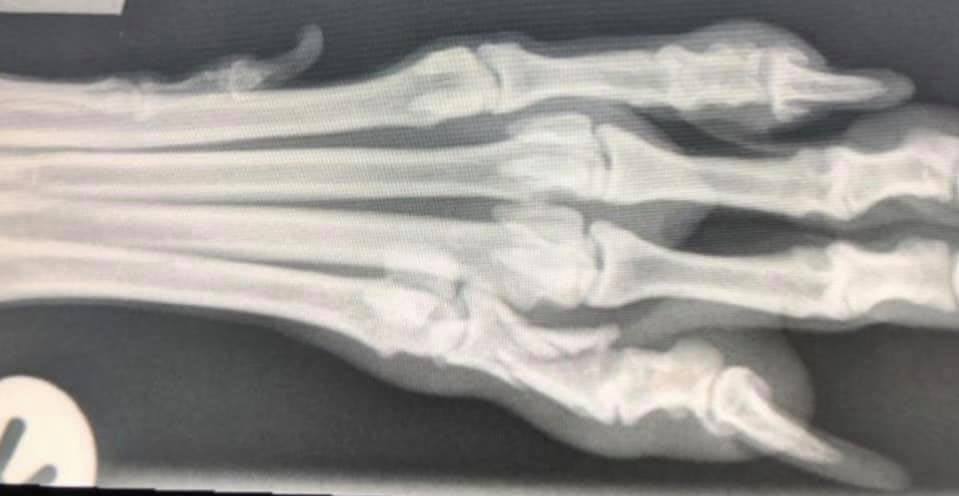
According to the Animal Welfare Act 2006: Section 9.
Duty of person responsible for animal to ensure welfare
2. (e) its need to be protected from pain, suffering, injury and disease.
“Greyhound racing is inherently dangerous. Greyhounds race at high speeds in conditions which make injuries almost inevitable.”
(Hansen 2017)
Every year in the UK there are just under 5,000 injuries recorded, resulting in the unnecessary deaths of hundreds of greyhounds with treatable injuries.
|
2017 |
2018 |
2019 |
Injuries |
4,837 |
4,963 |
4,970 |
|
|
|
|
Greyhounds with injuries killed trackside |
257 |
242 |
207 |
Greyhounds killed as trainers/owners did not want to pay treatment cost |
370 |
175 |
123 |
Greyhounds with injuries killed for poor prognosis, away from track |
144 |
142 |
|
|
|
|
|
Total Killed for injuries |
627 |
561 |
472 |
For over 40 years there have been many studies into racing greyhound injuries highlighting the damage the simple act of racing does to the bodies of greyhounds.
Drugging
The greyhound racing industry has a long and extensive history of animal welfare abuse related to the use of banned substances and illegal drugs. These include a range of drugs and banned substances that have been identified regularly in test samples- e.g. of hair and urine – taken from dogs involved in racing. These tests being performed are part of the racing industry’s own attempts to reassure the betting public of the integrity of racing, by trying to promote it as fair and above board.
But is it actually fair and above board on the greyhounds used within this commercial industry, when we look at their experiences involving drugs in a commercial industry?
How do greyhounds ingest drugs?
Firstly we need to understand that performance enhancing drugs are used to affect the track performance of a dog, and this includes a class A substance, cocaine.
Cocaine is a performance enhancing drug. Its known effects on dogs include increased heart rate, more blood pumped to the heart and lungs, and increased action / speed. It is also an illegal Class A drug and there are usually legal consequences for those people found with it, using it or supplying it in wider society.
We know from the independent press and TV exposures
https://www.gq-magazine.co.uk/sport/article/greyhounds-cocaine
that racing greyhounds have been given cocaine along with other drugs used to affect performance, with the aim of ‘rigging the betting’ or put simply, cheating.
